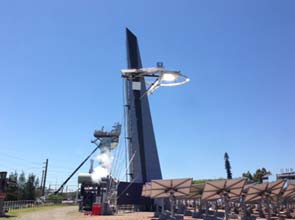In a solar thermal plant, heat from the sun is concentrated using mirrors or reflective surfaces onto a fluid to create steam. The steam is used to exert pressure that can turn a turbine to create electricity.
By using supercritical steam, solar thermal power plants could produce enough energy to become cost competitive with other forms of energy.
Australia’s national science agency, the Commonwealth Scientific and Industrial Research Organization or CSIRO, is pioneering a means to creating highly pressurized steam using solar power that they believe can improve the performance of solar thermal plants.
In a solar thermal plant, heat from the sun is concentrated using mirrors or reflective surfaces onto a fluid to create steam. The steam is used to exert pressure that can turn a turbine to create electricity.
Before CSIRO’s experiments, supercritical levels of steam have only ever been reached using the burning of fossil fuels. The best commercial solar thermal plants have been able to achieve has been subcritical steam, which doesn’t have the same pressure levels.
By achieving supercritical steam levels using solar, CSIRO is paving the way for the creation of more clean and renewable energy.
“Instead of relying on burning fossil fuels to produce supercritical steam, this breakthrough demonstrates that the power plants of the future could instead be using the free, zero emission energy of the sun to achieve the same result,” said Dr. Alex Wonhas, CSIRO’s Energy Director.
The breakthrough was made at CSIRO Energy Center in Newcastle which houses two solar thermal test plants. Using these test plants, the Advanced Solar Steam Receiver Project worked to improve solar thermal production.
The team developed a fully automated control system which predicts the heat delivered from every mirror in a solar thermal installation. This allows them to achieve maximum heat transfer while avoiding overheating. With this amount of control, the researchers were able to accurately recreate the temperature and pressures needed for supercritical success.
The world record, set in May of this year was a pressure of 23.5 megapascals and temperatures up to 570 degrees Celsius.
“It’s like breaking the sound barrier; this step change proves solar has the potential to compete with the peak performance capabilities of fossil fuel sources,” said Dr. Wonhas.
The $5.68 million research program is supported by the Australian Renewable Energy Agency and is part of a broader collaboration with solar thermal company Abengoa Solar. – EcoSeed Staff













